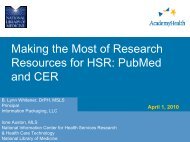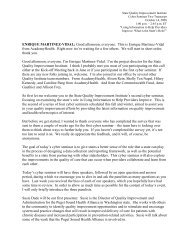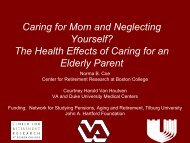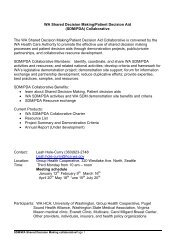Ohio Health Quality Improvement Plan
Ohio Health Quality Improvement Plan
Ohio Health Quality Improvement Plan
Create successful ePaper yourself
Turn your PDF publications into a flip-book with our unique Google optimized e-Paper software.
Appendix III — Su r v e y Resultsapproach on populations with multiple chronic conditions,32.3% believe that initial implementation should focuson children, 28.2% believe that all populations shouldbe focused on in the implementation, 27.4% believe thefocus should be on children with special health care needs,18.5% believe focus should be on populations with a singlechronic condition, and 10.5% offer an alternative response(rural access, uninsured, low income, Medicaid, andpatients with disabilities).<strong>Health</strong> Information TechnologyThe majority of respondents (71.2%) said they wouldtrust a non-profit with broad board participation to run astate wide health exchange. Approximately forty eightpercent (48.4%) prefer that the non-profit facilitate an EMRpurchasing collaborative and 36.9% prefer the non-profit toprovide an EMR as a service. Over forty-one percent(41.9 %) said they would pay a nominal fee toelectronically access patient data to which they do notcurrently have electronic access, 24.2% indicated theywould not pay a nominal fee and 33.9% didn’t feel they hadsufficient information to answer the question.Payment ReformRespondents overwhelmingly responded that the followingpayment reform strategies should be the same forgovernment programs and private health plans: expandingtraditional fee for service payments to cover activitiessuch as coordination of care and care management(86.7%); rewarding providers for improving healthoutcomes (87.5%); and paying providers for start up costsassociated with moving to the PCMH approach (72.9%).Approximately fifty nine percent (58.9%) believe thatpayment reform strategies should be implemented throughmandatory requirements, while 38.4% believe paymentreform strategies should be implemented through voluntarycompliance. When asked which payment reform strategyshould be implemented first, 40.2% agreed that strategiesto support medical homes should be implemented first;followed by strategies to support health informationtechnology (41.5%); and lastly, strategies to eliminateduplication, waste and errors in the delivery of care(38.7%).Informed and Activated Patients andIndividualsWhen asked to rank the order of importance of areas inwhich individuals often need help to effectively managetheir health and health care, 46.6% ranked assistance withmaking healthy lifestyle choices as the most important area.Assistance with making health care treatment decisions wasranked as the second most important area (41.3%) followedby assistance with making health care coverage decisions.Respondents ranked assistance with making end-of-lifedecisions as the least important area in helping patients toeffectively manage their health and health care.The following populations that often need support toeffectively manage their health and health care wereranked based on their potential for immediate impact(listed in order of most immediate to longest time forimpact): individuals with chronic illness (most immediate),uninsured individuals, individuals with public healthcare coverage, all <strong>Ohio</strong>ans under 65 years of age, andindividuals with employer-sponsored health coverage(longest time for impact).When surveyed, the majority of respondents indicatedthat web-based information, community activities, andmarketing campaigns are neutral to moderately ineffectivein helping individuals to become more engaged intheir health and health care. Respondents indicated thatencouragement or information from providers as well asfinancial incentives are the most effective ways of engagingindividuals in their health and health care. The majorityof respondents indicated that providers are moderatelyto very effective in informing and educating individualsabout their care. Respondents indicated that individuals aremoderately effective in educating themselves about theircare. Schools, communities, employers and health plans/insurers are moderately to neutrally effective in educatingindividuals about their care.29










